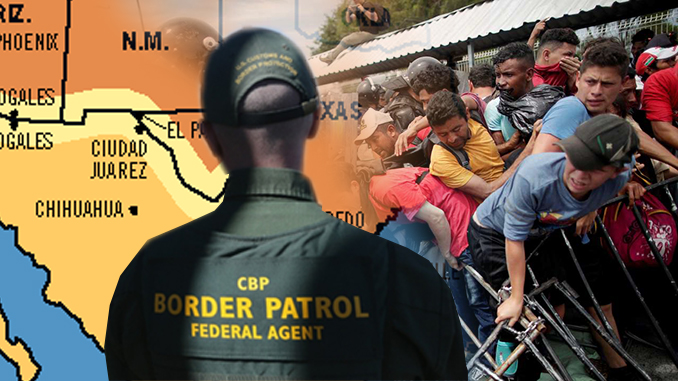
American Free Press Issue 19 & 20 extensively covered the situation at America’s southern border with three articles. Together, they make clear that there is, indeed, a crisis at the border.
Retired Texas Cop Gives AFP Firsthand Tour of the Border
By Mark Anderson
BROWNSVILLE, Texas—A retired Texas policeman recently took AMERICAN FREE PRESS on a guided tour of a key border crossing where, every day, he sees firsthand America’s border dilemma—something he has witnessed unfolding for decades.
“The border is actually a two-way street,” Rusty Monsees told AFP during an April 24 visit to his 21-acre homestead. “The criminal elements enter the U.S. to do their stuff but return to Mexico when the heat gets too hot and go back and forth several times as needed. And when the law gets too close down there, they come back to the United States. A Border Patrol agent once caught a guy with six different IDs. This is not a football game where everybody shakes hands at the end; this is dangerous stuff.”
The former San Benito, Texas cop pointed out that some of his acreage is actually south of the approximately 20-year-old border fence that runs past his house, which, oddly enough, is a good 100 yards north of the actual U.S.-Mexico boundary—the winding, murky Rio Grande River. He then started his Ford F-150 truck and led this writer through a gap in the border fence down to the river in order to show up-close what he and the Border Patrol he assists deal with on a regular basis. He keeps a rifle handy for self-defense at all times.
Asked about border differences since Donald Trump became president, Monsees said there are Mexican citizens who want a safer country and improved border security. Their attitude in the age of Trump has changed. They seem to have more resolve, especially in not wanting their own criminal elements crossing the border and “vacationing in the States,” as Monsees put it, so those elements can reorganize and head back to Mexico to continue their illicit activities.
What needs to happen, said Monsees, is a two-fence solution.

“So, let me get this straight. If I’m a cartel member or MS-13 gang member, I should first be encountering a fence before I even get to the Rio Grande River, a fence on the Mexican side?” this writer asked Monsees.
“Yes, that’s right,” he said, pointing to the river that is lined with a dense thicket of trees, especially on the Mexican side. This, he added, provides endless places for border-jumpers to hide.
Monsees contends that both the U.S. and Mexico should have an interest in border security. As a result, a truly effective fencing scheme would include non-rustable, sturdy, tall metal fencing laced with concertina wire and built on both sides of the river in key areas—with less reliance on the existing gap-ridden “tactical infrastructure” fencing, as the U.S. government calls it, which is rusting and too often can be climbed or otherwise circumvented by the more determined among the illegal aliens.
Monsees pointed out another thing often overlooked, which is a border breach of a different sort. Mercury, lead, diazinon, and trace uranium get into the Rio Grande River via the discharges from the maquiladoras, the large factories with reportedly bad working conditions and poor wages built under the soon-to-be-replaced North American Free Trade Agreement.
ACROSS THE BORDER
This writer then visited Matamoros, just across the border in Mexico from Brownsville, where there was a small “tent community” that included three Cubans who hope to enter the United States.
A young man named Pablo, accompanied by a pregnant woman about 20 years old and another young man, said they were hoping she can give birth in the U.S., evidently for welfare assistance.
He claimed they were flown in a plane from Cuba to Brazil. Between October and now, they said they reached the Texas border mainly by bus.
Mark Anderson is AFP’s roving editor. Email him at [email protected].
Border Patrol Chief Recounts the Immigration Turmoil, Real Crisis
By Mark Anderson
McALLEN, Texas—Acting Rio Grande Valley (RGV) Sector Border Patrol Chief Hector Escamilla, speaking at the McAllen Citizens League’s luncheon April 25, outlined the daunting task carried out by the Border Patrol to reduce the overall flow of illegal immigrants and focus on the criminal element that steadily enters the U.S. While his assessment of the border crisis and some recommended solutions corroborated important matters American Free Press has reported on, Escamilla added some clarifying points to illustrate the complexity and severity of the crisis.
A 30-year Border Patrol veteran, Escamilla explained that the Border Patrol, which has 3,100 agents in the four-county RGV sector, needs to press for specific policy changes that will increase deportations and result in a “package deal” where the “wall,” helpful though it may be, is one of several coordinated measures needing to be implemented.
Having 3,100 agents may sound impressive and adequate, but by the time sick leave, vacations, and administrative-desk duties are covered, only half of those 3,100 officers end up being “boots on the ground” at any given time—for a border sector covering “316 river miles, from the mouth of the Rio Grande all the way to the Falcon Dam; that’s a pretty daunting task,” Escamilla said.
He clarified: “A lot of the area we cover is dense brush . . . the lateral mobility is very difficult because a lot of the land that we patrol is owned by personal landowners . . . we can’t just traverse continuously along the river.” In addition, government and private wildlife refuges along the border, heavily regulated in a manner that prevents border agents from “mowing the place down” to find hidden illegal immigrants, further complicate the issue.
What’s more, Border Patrol must help guard the coastal counties. “We’re actually responsible for the entire [Gulf] shoreline, all the way to the Louisiana border,” said Escamilla. “So we do have agents in different places along the coastline.”
He added that, in the RGV sector alone, 165,000 illegal immigrants have been apprehended at the border since the start of the fiscal year (Oct. 1, 2018). During the same period there has been a 150% increase of “OTMs” (other than Mexicans) illegally entering the U.S.
He explained, “The majority of the OTMs are from the Central American countries of El Salvador, Nicaragua, Guatemala, Honduras.”
Pressing Escamilla to confirm that people from more than 40 nations, including overseas, are illegally entering the U.S, this writer interjected, “We hear about Asia, the Middle East and even Europe.”
 His response: “Yes, we’ve got Middle Eastern folks here. We’ve got Iraqis, Iranians, a lot of Chinese— Chinese are more common than people might think . . . Pakistanis and Cubans, we’re catching Cubans. These people bring in lots of money for the cartels—$15,000 to $20,000 per person. We estimate that the cartels are making as much or more money from human trafficking than they do from the actual smuggling of narcotics.”
His response: “Yes, we’ve got Middle Eastern folks here. We’ve got Iraqis, Iranians, a lot of Chinese— Chinese are more common than people might think . . . Pakistanis and Cubans, we’re catching Cubans. These people bring in lots of money for the cartels—$15,000 to $20,000 per person. We estimate that the cartels are making as much or more money from human trafficking than they do from the actual smuggling of narcotics.”
Asked by another audience member to explain the asylum situation, Escamilla said: “The majority of those who come here, they come from economic-hardship countries. That’s usually what they tell us as the reason they’re fleeing. . . . There is in most of those Central American countries a lot of poverty, a lot of gangs, violence, including MS-13 and so on. But . . . the reasons for asylum should be specific to the individual. Did the cartels, did the gangs in their country of origin specifically target them for political reasons, and not so much because there’s an economic crisis in the country?”
Stressing a recommended procedural change, Escamilla remarked: “We’d like to see asylum officers actually accessible at the Border Patrol stations. In fact, there’s talk of Border Patrol agents themselves having the authority to listen to asylum claims, so we can expedite the process. But, of course, that’s being met with a lot of resistance. It’s going to be met with a lot of lawsuits.”
Asked by this writer whether the Border Patrol needs another 4,000 agents in addition to the 3,100 in the RGV sector, Escamilla replied that hiring significantly more agents and obtaining the authority to assign more personnel to screen asylum requests are two steps toward developing a solution—along with hiring more immigration judges.
“We really do need a lot of different factors and one of them is policy,” he said. “Until we start returning some of these migrant families and children back to their country of origin quickly . . . to make it more difficult for them to make a second or third trip . . . then, I don’t care how many agents you give us, it’s not going to do us any good. There’s got to be a change in policy. We’ve got to communicate with the heads of these countries and ask, why can’t you take your people back quicker?”
Both Sides of the Border Need to Be Safeguarded
By John Friend
The crisis along the southern border between the United States and Mexico continues to spiral out of control as thousands of migrants attempt to illegally enter the United States on a daily basis, many with entirely fraudulent claims and documentation.
According to a recent report published by The Epoch Times, U.S. Border Patrol officials have identified over 3,000 cases in the past six months alone that involve fraudulent family unit claims made by migrants seeking asylum or permanent resettlement in America, demonstrating the increasingly difficult situation immigration officials find themselves in when screening migrants and asylum seekers.
“It’s very clear that the cartel and smugglers know the weaknesses in our laws,” acting Homeland Security Secretary Kevin McAleenan, said in an April 18 press conference while he was visiting the border near McAllen, Texas. “They know that family units and unaccompanied children will be released with no consequences for their illegal entries.”
McAleenan took over the department following the April 7 resignation of Kirstjen Nielsen, who was often criticized by President Trump.
Migrants seeking entry to the U.S. are often screened, processed, and then released into the country, especially if they have children traveling with them. By law, family units must be released upon entry rather than being turned away or detained, allowing illegal aliens, human traffickers, and cartels to exploit U.S. immigration laws.
“The same child is brought across the border with an adult multiple times to try and gain that release that family units are required under court order,” McAleenan stated.
According to McAleenan, 4,800 migrants attempted to illegally cross the U.S. border on April 16 alone, underscoring the seriousness of the situation. The 4,800 marked “a new record for the modern era,” he added. “Almost 1,000 of them crossed in just three large groups, 375 people in the largest of those groups.”
Last month, Border Patrol agents encountered 103,000 individuals along the southwest border, with 92,000 of those individuals being apprehended by agents, marking a 35% increase of apprehensions from the previous month. In the Rio Grande Valley region of Texas, Border Patrol agents have already surpassed the total number of apprehensions during the 2018 fiscal year.
“Last fiscal year, Border Patrol agents in the Rio Grande Valley (RGV) Sector apprehended 162,000 individuals,” Supervisory Border Patrol Agent Marcelino Medina told reporters in late April. “For the first seven months of this fiscal year, we’ve already surpassed that number.” In the RGV region alone, agents are averaging 1,100 apprehensions every single day.
Sydney Hernandez, a local news reporter for KGBT in the RGV region, interviewed a number of migrants seeking entry to the U.S. recently. Many stated that they are being told in their home countries that they will receive help and assistance from the U.S. government if they enter illegally.

“Immigrants tell me they’re coming to the U.S. because they’re seeing advertisements on their local newspapers and TV stations, about better opportunities and free help from Americans if they enter illegally,” Hernandez reported.
Illegal aliens are not supposed to receive government benefits, but many do. According to a 2017 study conducted by the Federation for American Immigration Reform (FAIR), illegal immigrants consume over $100 billion in taxpayer money every year. With countless migrants now entering the U.S. daily, that amount will only increase.
“We’re talking about billions of dollars in taxpayer benefits over the next few years,” FAIR Director Dan Stein explained to Fox News recently. “The payout for the taxpayer is enormous, and income to the Treasury is miniscule.”
Overall, illegal immigrants receive more government benefits than they contribute via taxes. Many receive free public schooling, medical care, housing assistance, food stamps, and other social services.
DISARMED
In related news, two U.S. soldiers who were conducting surveillance along the border, south of the border fence but north of the Rio Grande River, were confronted by Mexican soldiers armed with assault rifles.
“On April 13, 2019, at approximately 2 p.m. CDT, five to six Mexican military personnel questioned two U.S. Army soldiers who were conducting border support operations in an unmarked (Customs and Border Protection) vehicle near the southwest border in the vicinity of Clint, Texas,” U.S. Northern Command (USNorthCom) explained in a statement to CNN. “The U.S. soldiers were appropriately in U.S. territory.”
During the incident, the Mexican troops pointed their weapons at the soldiers and disarmed one of them, returning the sidearm to the vehicle. According to USNorthCom, an inquiry determined the Mexican troops believed the U.S. soldiers were on the Mexican side of the border. Thus far, President Donald Trump has not commented on this potentially explosive situation.
MILITIA LEADER ARRESTED
Meanwhile, the FBI has arrested a leader of a militia group in New Mexico whose organization was attempting to stop illegal immigrants from entering the U.S., it was recently reported.

Larry Hopkins, 69, was arrested on April 26 on a federal complaint charging him with being a felon in possession of firearms and ammunition. Hopkins’s group, the United Constitutional Patriots (UCP), has reportedly detained close to 5,600 illegal aliens in recent months in an effort to help Border Patrol agents and immigration officials deal with the increasingly lawless southern border. Hopkins and his group have been denounced and criticized by the governor of New Mexico and other left-wing, open-borders activist groups, including the Southern Poverty Law Center and the American Civil Liberties Union.
Members of the UCP are convinced Hopkins will be cleared and are proud of their righteous cause.
“We’re not worried about it,” stated Jim Benvie, a spokesperson for the group. “He’s going to be cleared.”
John Friend is a freelance author based in California.






